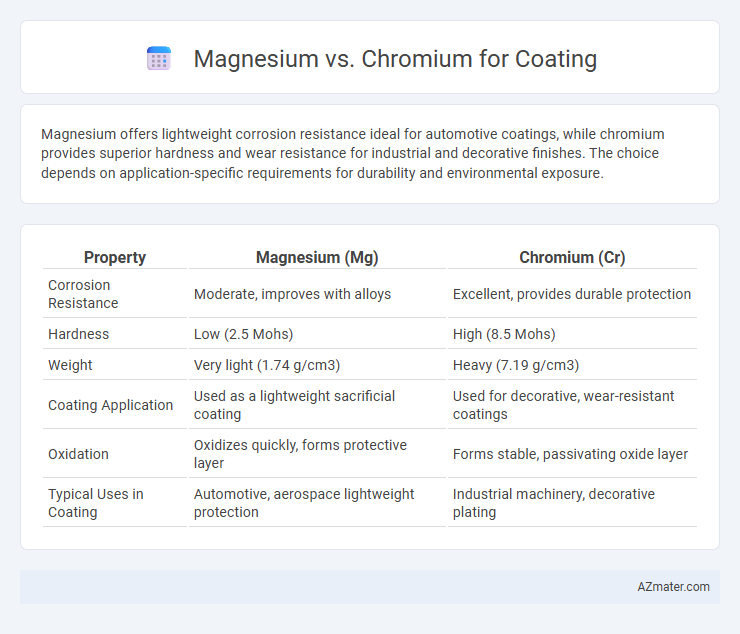Magnesium offers lightweight corrosion resistance ideal for automotive coatings, while chromium provides superior hardness and wear resistance for industrial and decorative finishes. The choice depends on application-specific requirements for durability and environmental exposure.
Table of Comparison
| Property | Magnesium (Mg) | Chromium (Cr) |
|---|---|---|
| Corrosion Resistance | Moderate, improves with alloys | Excellent, provides durable protection |
| Hardness | Low (2.5 Mohs) | High (8.5 Mohs) |
| Weight | Very light (1.74 g/cm3) | Heavy (7.19 g/cm3) |
| Coating Application | Used as a lightweight sacrificial coating | Used for decorative, wear-resistant coatings |
| Oxidation | Oxidizes quickly, forms protective layer | Forms stable, passivating oxide layer |
| Typical Uses in Coating | Automotive, aerospace lightweight protection | Industrial machinery, decorative plating |
Introduction to Coating Materials
Magnesium and chromium serve distinct roles in coating applications due to their unique material properties; magnesium offers lightweight corrosion resistance with good thermal conductivity, making it ideal for automotive and aerospace components. Chromium provides exceptional hardness and wear resistance, commonly used in decorative and protective coatings such as chrome plating to enhance durability and aesthetic appeal. Selecting between magnesium and chromium coatings depends on specific performance requirements including environmental exposure, mechanical stress, and desired lifespan of the coated surface.
Understanding Magnesium and Chromium
Magnesium offers lightweight properties and excellent corrosion resistance, making it ideal for coatings on automotive and aerospace components where weight reduction is critical. Chromium provides superior hardness and wear resistance, forming durable and corrosion-resistant coatings commonly used in industrial machinery and tools. Understanding the distinct physical and chemical properties of magnesium and chromium helps optimize their application for protective and functional coatings.
Key Properties Relevant to Coating
Magnesium offers excellent lightweight properties and corrosion resistance, making it ideal for automotive and aerospace coatings requiring durability with minimal weight addition. Chromium provides superior hardness and scratch resistance, crucial for protective coatings that demand long-term wear and aesthetic appeal. Both metals exhibit distinct electrochemical behaviors; magnesium tends to act as a sacrificial anode in corrosion protection, while chromium's passivation layers enhance surface stability and oxidation resistance.
Corrosion Resistance: Magnesium vs Chromium
Chromium coatings provide superior corrosion resistance compared to magnesium due to their dense, protective oxide layer that effectively shields underlying metals from oxidation and environmental damage. Magnesium coatings, while lightweight and beneficial for certain applications, tend to be more susceptible to corrosion because of their higher reactivity and less stable oxide formation. In industrial applications requiring long-term durability and resistance to harsh environments, chromium remains the preferred coating material.
Durability and Longevity Comparison
Magnesium coatings offer excellent corrosion resistance and lightweight properties, enhancing durability in automotive and aerospace applications. Chromium coatings provide superior hardness and wear resistance, contributing to longer-lasting surface protection in industrial machinery. Comparing both, chromium generally outperforms magnesium in longevity under high-friction environments, while magnesium excels in applications requiring reduced weight and moderate corrosion protection.
Application Processes for Each Metal
Magnesium coating is primarily applied using thermal spray techniques such as arc spraying and plasma spraying, offering excellent corrosion resistance in automotive and aerospace industries. Chromium coatings commonly utilize electroplating and physical vapor deposition (PVD) methods, providing superior hardness and wear resistance for industrial and decorative applications. Each metal's application process is optimized for specific performance requirements, with magnesium favoring lightweight protective layers and chromium excelling in durable, high-gloss finishes.
Cost-Effectiveness: Comparing Expenses
Magnesium coatings often provide a cost-effective solution due to their lightweight properties and lower raw material costs compared to chromium plating, which involves higher expenses related to toxic chemical treatments and waste management. Chromium coatings, while offering superior hardness and corrosion resistance, typically incur greater operational and environmental compliance costs. Evaluating total expenses, magnesium coatings can reduce overall investment in applications where moderate protection suffices, making them economically advantageous for large-scale or budget-sensitive projects.
Environmental Impact and Safety
Magnesium coatings provide a lightweight, biodegradable alternative with lower toxicity, reducing environmental impact and minimizing health risks during application and disposal. Chromium coatings, especially hexavalent chromium, pose significant environmental hazards due to their carcinogenic properties and persistence in ecosystems. Choosing magnesium over chromium enhances workplace safety and promotes sustainable coating practices by mitigating harmful emissions and toxic residue accumulation.
Common Industries and Uses
Magnesium and chromium coatings are widely used across the automotive, aerospace, and electronics industries due to their distinct protective and functional properties. Magnesium coatings offer lightweight corrosion resistance and improved thermal conductivity, making them ideal for electronic components and aerospace parts. Chromium coatings provide superior hardness and wear resistance, commonly applied in automotive trim, industrial machinery, and decorative finishes.
Choosing the Right Coating: Factors to Consider
Magnesium coatings provide exceptional corrosion resistance and lightweight protection, making them ideal for automotive and aerospace applications where weight reduction is critical. Chromium coatings offer superior hardness and wear resistance, suited for industrial machinery exposed to high friction and abrasive environments. Selecting the right coating depends on factors such as environmental exposure, desired durability, and specific mechanical requirements of the component.

Infographic: Magnesium vs Chromium for Coating
 azmater.com
azmater.com